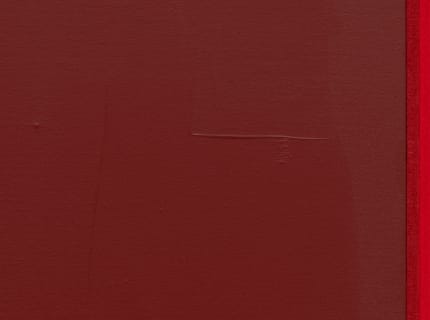FOR NEARLY THREE DECADES, Jennie C. Jones’s interdisciplinary practice has encompassed painting, sculpture, installation, and sound. Frequently working with industrial materials like fiberglass acoustic panels and architectural felt, Jones has developed a visual language that draws on the aesthetics and concepts of Minimalism. Her works often materially reference audio culture, but are noticeably quiet. In the 2000s, she began using acoustic ephemera such as cables, tape cassette cases, and CD racks to create sculptures that pun on sound production and increasingly obsolete analog formats. By 2011, Jones was painting commercial acoustic panels like monochromes, suggesting visual as well as sonic absorption. Her first outdoor sculpture, These (Mournful) Shores, a colossal riff on the ancient aeolian harp, a self-playing instrument, was appended to a Tadao Ando–designed wall extending from the Clark Art Institute in Williamstown, Massachusetts, in 2020. Rather than presenting discrete sounds, these works are containers for aural attention, delineating spaces where the viewer can reflect not only on their own sensory encounters but also on the varied histories of art, architecture, and music that the works invoke.
Jones’s Minimalist forms emerge from a desire to map other histories of modernism––and to trace her relationship to those histories, most notably the silenced, or muted, history of Black avant-garde producers of visual art and music. Jones’s latest work, Ensemble, is her second foray into outdoor sculpture. This installation for the Metropolitan Museum of Art’s Cantor Roof Garden comprises four sculptural elements that explore the sonic and formal potential of simple stringed instruments. On view through October 19, Ensemble is the final commission for the roof garden, which has served as a vivid setting for site-specific installations since it opened in 1987. A new series of commissions will begin in 2030, when the Met will reopen a transformed wing for modern and contemporary art.
—Caitlin Woolsey
AS PART OF conceptualizing Ensemble, I created preparatory “scores”—works on paper using collage and acrylic—as a primer to start considering what the scale and volume would look like. These studies were also really an investigation of color, thinking of the way graphic scores can work and trying to convey a mood or tone through color theory. I struggled a lot with color for this project: The color needs to have gravity and hold space in a different way because there is so much visual competition up there—and because the work is sitting on top of five thousand years of art. Early on I was thinking about Fred Wilson’s “Mining the Museum” [1992–93], but then I decided that I’m going to give myself all the freedoms that the white guys get. It’s not my responsibility to address the history of the museum underneath me, but instead to hold space on a rooftop and be forward-thinking.
These are the biggest sculptures I’ve ever made. The scale was challenging; I kept making the joke that I’m an inside cat, and here I am, working on this large outdoor commission. It’s hard to think about scale when the scale that you’re comparing the work to is the sky. An element that feels really huge at a foundry could be totally dwarfed once it’s up there on the roof.
...
Read full article at artforum.com.

